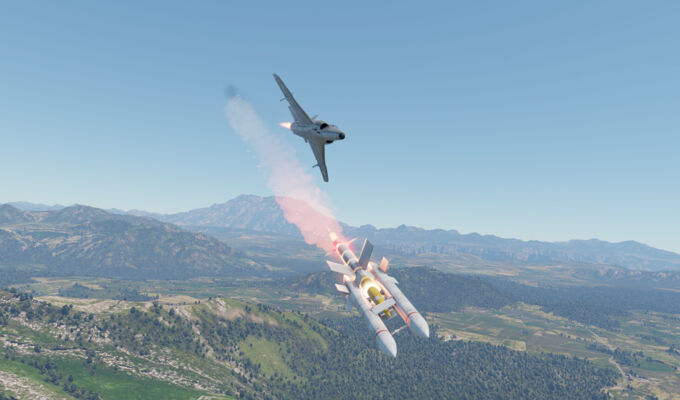The Fireflash is the first attempt the United Kingdom made at a guided air-to-air missile. Designed in 1949, it entered service in 1957 where it only remained for a year. Found on the British Swift F.7, it is the only beam-riding (SACLOS) AAM in-game, meaning it goes where your airplane's nose is pointing.
| Missile | Fireflash |
| Mass (kg) | 150 kg |
| Guidance | SACLOS |
| Maximum Speed | 1500 m/s |
| Explosive Mass (TNT) | 7 kg |
| Maximum Overload | 10 G |
| Launch Range | 4 km |
| Pros | Cons |
|---|---|
| Not affected by Countermeasures | Low G-Overload |
| High missile speed | Requires manual guidance |
| Very unique and satisfying | Inaccurate guidance |
| Very early AAM | Short range |
It's certainly one of the most fun missiles I used in a while (if it worked). The problem is that the missile feels very janky in the game, as it only starts to maneuver a few seconds after the launch, and then also very unreliably as it sometimes pulls into a completely different direction than the one your nose is pointing in.
History
In 1945, the Air Ministry began work on the “Red Hawk” air-to-air missile, based on earlier Royal Aircraft Establishment research into radar-homing and beam-riding technology. By 1947, the RAE focused on its guided weapons projects, leading to the development of the “Blue Sky” missile in 1949, intended for attacking piston-engine bombers. Fairey Aviation improved the design by using custom “Stork” rockets for propulsion, with boosters that fell away during flight. It later received its name “Fireflash” by the RAF during development.
The Fireflash missile was first introduced in 1953, with the first successful test firing destroying a drone aircraft. The missile was used primarily in testing mounted on Supermarine Swifts and Gloster Meteors. It entered service with the RAF in 1957, but was decommissioned just a year later. Only 300 Fireflash missiles were ever built, as the RAF opted not to continue production due to more advanced designs on the horizon. The Fireflash was then replaced by the Firestreak, ending its very short life span.
Image Source
Use in Game
Using the Fireflash in-game is quite…tricky. It only starts actually trying to pull its overload of 10G a couple of seconds after it is launched, and you will have to keep the red flare close to your plane's nose, as it will otherwise lose your radar beam and just fly straight, exploding after 4 km.
If trying to shoot down nimble aircraft, it is best used in head-ons at a range of about 1-2km. Trying to use it in rear-aspect will prove very hard as its range is limited, and it will start to lose maneuverability quickly because its burn time is very short and its energy retention is subpar. Another good way to use it is to intercept bombers, as they are slow and very large, making them an easy target.
It is also possible to use the radar gunsight to guide the missile in automatically, but I advise against it as it tends not to work. It will be affected by disturbances like chaff or ground clutter. Its range is very limited, and I often find myself losing lock at over 1 km.
You can, of course, use it for moderate to high angles shots too, but you will have to use it more like an unguided missile. It is just not able to make such quick maneuvers due to its low overload and bad energy retention.
Conclusion
Overall, Fireflashes are not “game-changing” missiles. They don’t pull well, they are inconsistent, are heavy and not aerodynamic, lowering your top speed dramatically. But…they are the only all-aspect missiles found at such a low rank (with the exception of the French S.O.4050 Vautour IIN, which has SARH and MCLOS missiles, and the majority G.91's which have MCLOS missiles too), which makes them very fun to use, especially against planes with countermeasures who will try to flare you missile, only to see it fly right through. In real life, the Fireflash had a very short lifespan, as it was proved obsolete after a very short time by the Firestreak.
And with that I will wish you all good luck with the only air-to-air beam-riding missile in the game. Thank you!



